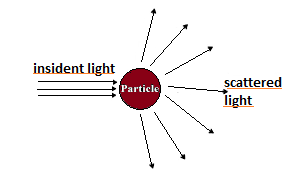
Why are the stars not during the day?
A. Because of the bright light of the sun.
B. Because they are covered by clouds.
C. Because the shadow of the earth falls on them.
D Because their light cannot reach the earth during the stay.
Answer
572.4k+ views
Hint: Sunlight can scatter a lot with the help of obstacles between the path of the light. This phenomenon is known as the scattering of light. The distance of the earth from the sun is less during the day time so that the scattered light is so bright that the other objectives (stars) are not visible during the daylight time.
Complete answer:
When light passes through one medium and enters into another medium then a part of the light is absorbed by particles of the medium. This phenomenon is known as a scattering of light. The intensity of scattered light depends on the size of the particle through which scattering is taking place and the wavelength of the light.

Shorter wavelength and high-frequency EM waves scatter more due to the waviness of the line and its intersection with a particle. The waiver of the line of light, the more will be the chances of its contact with the particles. On the other hand, when we talk about longer wavelengths, they have low frequency, and they are straighter (not too waiver) that’s why their chance of colliding with the particles decreases.
Stars are not visible in daylight due to the light-scattering phenomenon taking place in the atmosphere spreads sunlight across the sky. Seeing the light of a distant star through the sheet of scattered light produced by the scattering of sunlight becomes difficult or you can say that it is next to impossible.
So the option which satisfies the question is option A.
Note: Invisibility of start is a result of the scattering effect of light and not of diffraction of light. The sun is closer to earth during day time that is the main reason for the invisibility of distinct stars.
Complete answer:
When light passes through one medium and enters into another medium then a part of the light is absorbed by particles of the medium. This phenomenon is known as a scattering of light. The intensity of scattered light depends on the size of the particle through which scattering is taking place and the wavelength of the light.

Shorter wavelength and high-frequency EM waves scatter more due to the waviness of the line and its intersection with a particle. The waiver of the line of light, the more will be the chances of its contact with the particles. On the other hand, when we talk about longer wavelengths, they have low frequency, and they are straighter (not too waiver) that’s why their chance of colliding with the particles decreases.
Stars are not visible in daylight due to the light-scattering phenomenon taking place in the atmosphere spreads sunlight across the sky. Seeing the light of a distant star through the sheet of scattered light produced by the scattering of sunlight becomes difficult or you can say that it is next to impossible.
So the option which satisfies the question is option A.
Note: Invisibility of start is a result of the scattering effect of light and not of diffraction of light. The sun is closer to earth during day time that is the main reason for the invisibility of distinct stars.
Recently Updated Pages
Master Class 10 General Knowledge: Engaging Questions & Answers for Success

Master Class 10 Science: Engaging Questions & Answers for Success

Master Class 10 Social Science: Engaging Questions & Answers for Success

Master Class 10 Maths: Engaging Questions & Answers for Success

Master Class 10 English: Engaging Questions & Answers for Success

Master Class 10 Computer Science: Engaging Questions & Answers for Success

Trending doubts
Which places in India experience sunrise first and class 9 social science CBSE

Fill the blanks with the suitable prepositions 1 The class 9 english CBSE

Write the 6 fundamental rights of India and explain in detail

Difference Between Plant Cell and Animal Cell

What is the Full Form of ISI and RAW

Golden Revolution is related to AFood production BOil class 9 social science CBSE




